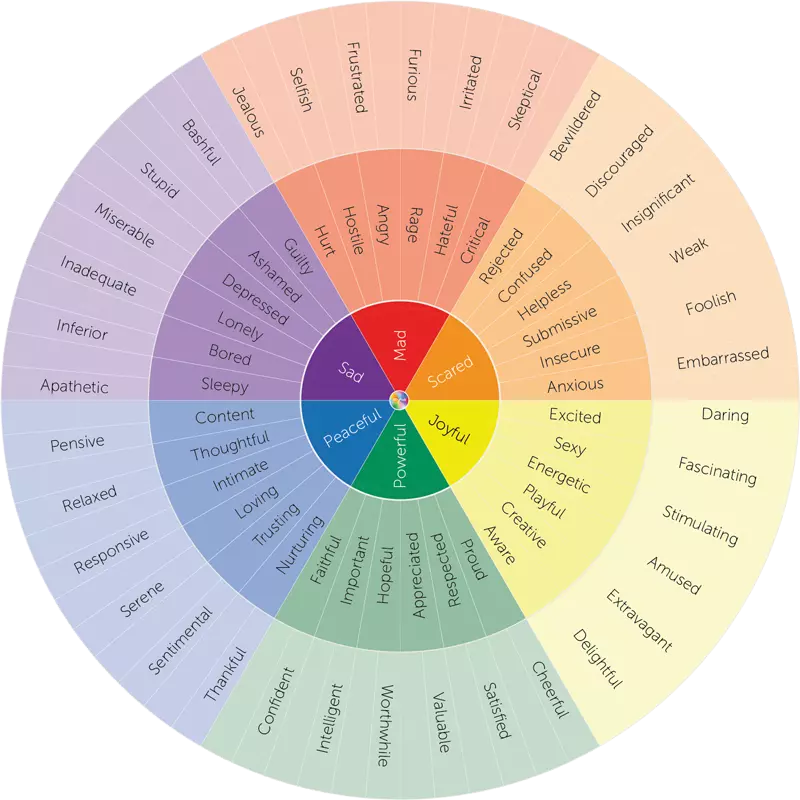How to Feel Your Feelings in 5 Easy Steps
Learning how to feel your feelings is not a skill many people have in our world today. Yet, we all experience feelings and emotions because it is part of the human experience. Because we are pleasure driven people, we tend to avoid unpleasant feelings or emotional pain- it’s second nature. We tend to move away from our difficult feelings by avoiding, stuffing and distracting from what our difficult emotions are trying to tell us. The reality is, our emotions are signals trying to tell us something. When we learn how to feel our feelings, we improve our emotional awareness and emotional intelligence.
Learning how to feel your feelings yields incredible insights into our internal experience, which guides us to our next step in any situation we face. Additionally, we will experience healthier relationships and navigate daily life with more awareness. In this article, we are going to cover practical ways to practice pausing, naming our feelings, spending time with our feelings and getting curious. Are you ready to become an expert on your emotional experiences?
It’s wise to reflect on what your current patterns of navigating negative emotions are currently. As I mentioned earlier, we tend to avoid negative feelings. Pay attention to what you do when those negative feelings come up. Do you distract yourself? Some people stay very busy to avoid experiencing any negative emotions. Others stuff those feelings deep down and pretend everything is okay by masking negative emotions with positive emotions.

Do you avoid uncomfortable feelings?
Take a minute and reflect on how you address intense emotions. We can’t change what we don’t know. The next questions is, why do you avoid uncomfortable feelings? What has happened in the past when you have had strong emotional reactions? Did the people around you chastise you for expressing your hard feelings? Did you receive the message that feelings were bad? It’s possible you perceived that you were insignificant because you weren’t given permission or encouraged to share. All of this can lead to avoidance behavior as a way to escape unpleasant emotions. This probably was a skill you learned in childhood because the people in your life didn’t know how to guide you through uncomfortable emotions. Or, they were easily overwhelmed. But, it might be time to do a new thing! Let’s see if you can gain some skills to navigate through strong emotions instead of going around them.
Why is it hard for me to feel my feelings?
As just mentioned, you might not have had anyone to help you regulate your emotions when you were growing up. Or, you might have tried to express emotions and it was shut down and discouraged. In any case, learning how to feel your feelings is a skill that is taught, but never too late to learn! Like anything, as we practice feeling our feelings, we will become a pro at what is going on within us. This wealth of understanding will help us- by recognizing and acknowledging your own emotions, you can develop a deeper understanding of your own needs, values, and experiences. All of that to say, if it’s hard to feel your feelings right now, it doesn’t always have to be that way. You can gain the tools offered below and begin practice feeling your emotions. Don’t think of it as a light switch that has an off/on, rather, think of it as a continuous area to grow in. Be patient with yourself- like riding a bike, it’s a bit shaky at first, but soon you will be zooming all over the place!
Feelings and Emotions are Signals
I want you to think of emotions as signals. Imagine you are driving your car down the road and the check engine light comes on. That is a signal to deeper issues in the car, right? You likely won’t ignore that light for too long because it can lead to more mechanical problems. Well, this is the same function of emotion or feelings in our lives. They are signals that can alert us that something is going on- deeper issues in our heart that need to be addressed. Do you think you could practice viewing your feelings as a great way to learn more about yourself and the world around you? It can be scary at first to face our emotional responses. Willingness is the first step to improving your emotional health. It is completely possible, even necessary, to learn how to deal with intense feelings. It’s been my experience that if you don’t face your emotions now, they will demand to be addressed at some point. When we avoid negative feelings, mental health issues such as anxiety and depression can begin to grow. No better time than the present to start!
Coping Mechanisms
While learning how to feel your feelings is a powerful way to grow in your self awareness, it can be quite painful to address difficult or intense emotions. Finding coping mechanisms are a good way to help you manage uncomfortable feelings. Later in this article we cover an easy 5 step guide to feel your feelings and the assumption is that we tend to avoid negative feelings. I want to encourage you to practice feeling your positive feelings. Pay attention to when you feel good and start there. It might be helpful to seek wise counsel when starting to practice feeling your feelings. Someone who is skilled at navigating emotions might be better equipped to help you through hard emotions while managing the pain at a more tolerable rate. Others can also offer a different perspective. Support groups for specific areas of support might be a good way to navigate feelings. Mental health check ins are another way to work though emotions before they build up. Setting up extra support by having someone you trust, like a good friend help you is also important. Give yourself time to move through uncomfortable emotions. Leaning into your faith is vital when navigating the deep waters of your heart as well.
Easy Guide on How to Feel Your Feelings
1. Practice the Pause
This is the moment that “check engine” light comes on. When I feel an intense feeling, I usually have physical sensations first. Pausing helps us tune into what is happening in our heart, body and mind. This is the moment that you will have to make a choice to avoid it or face it head on. It’s a good idea to find a quiet place where there are no distractions. Pause and be still, take a deep breath in through your nose and release it slowly through your mouth. What are you feeling in your body? Pay attention to where you are experiencing physical sensations in your body. For example, you may feel hot or tightness in your chest. Are you noticing that you are shaking or your heart is pounding? These are examples of physical sensations that you can begin to notice and pay attention to.
2. Name the Feeling
Now it’s time to name the feelings. This can be so helpful in developing emotional awareness and in regulating your emotions, which is a fancy way of saying managing your emotional state and reactions. While this may seem like a simple step, sometimes it can be the more challenging part of the process because we have a limited emotional vocabulary. The best way to name emotions is taking a peek at a feelings wheel developed by Gloria Willcox. The feelings wheel has 6 core emotions that will give you a starting point to name your true feelings and then you can further detail what you are experiencing. By recognizing and acknowledging your own emotions, you can develop a deeper understanding of your own needs, values, and experiences. This can also help you cultivate empathy and compassion for others, as you are better able to understand and connect with their emotions.

3. Just Notice
The next step is spending time with your feelings and emotions. This step will tempt you to judge or label your emotions, but refrain from doing that. For example, we might notice we are feeling angry and immediately tell ourselves we “shouldn’t” be angry (judging). Or we will tell ourselves anger is “bad” (labeling). This is what I want you to avoid. Instead, I want you to give yourself permission to just feel the real emotions. Two words- “just notice” what you are feeling.
4. Get Curious
This step is a healthy way to dig deeper. Reflect on your emotions. Consider how your emotions are impacting your thoughts, behaviors, and interactions with others. These are typically “why” questions. Ask yourself why you are having these emotions. What happened right before you felt this way? Were there past situations that brought up the same feelings? Perhaps childhood trauma or a traumatic event is triggering painful feelings. Were your values, expectations or boundaries violated? What need is this feeling communicating to you? In simpler terms, what do you need? Ask yourself if there are any patterns or themes in your emotions that you have noticed over time.
5. Be Kind to Yourself
We can be very hard on ourselves, especially when we are dealing with hard times and hard emotions. It’s quite common to notice negative emotions and then beat yourself up over it. Remember, feeling emotions and feelings is part of the human experience. Nobody can avoid experiencing emotions- you were made as feeling beings. Practice self-compassion by talking to yourself like a dear friend, dumping “should statements” and stopping negative self talk. Instead, give yourself permission to experience the difficult feelings in your own time. There is no rush!
Wrapping Up: How to Feel Your Feelings
Learning how to feel your feelings is a vital skill to your emotional well-being. Many of us were raised in an environment that did not encourage emotional expression. We might have received the message that emotions are bad and we are bad for having any negative emotions. But, here is the truth- everyone experiences emotions- good, bad and ugly. Those emotions are signals to a deeper understanding of our own needs, values and experiences. When we pause and reflect on our feelings, we learn quite a bit about ourselves. Emotional awareness will increase and mental health issues will decrease. It’s vital that we learn healthy ways of navigating difficult emotions and difficult times.
The 5 step guide is a great way to start feeling your feelings. First, we must pause and reflect on what we are feeling- in our body and in our emotions. Next, we must name our feelings. While this can be challenging, an emotions wheel can be very helpful in putting words to emotions. Third, just notice what the feelings are without judgment or labeling. Then, ask yourself questions about why you are having the emotions you named. Such as, what need is this feeling communicating to you? And finally, be kind to yourself as you navigate intense emotions.
Related: How to Process Emotions

Thank you for this. Perfect words at the perfect time.
Thank you for this wonderful explanation. It is so very helpful.
[…] How to Feel Your Feelings […]
[…] How to Feel Your Feelings […]